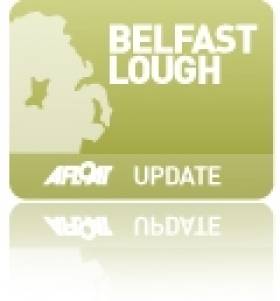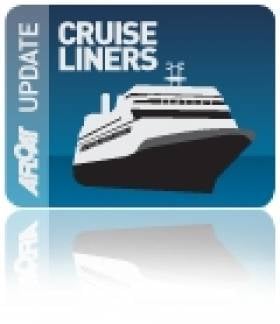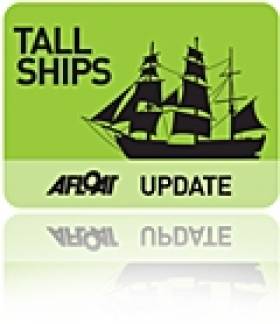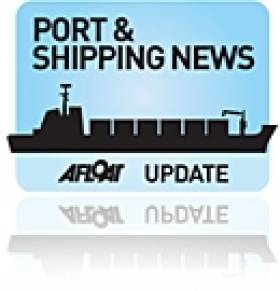Displaying items by tag: Belfast Harbour Commissioners
#BelfastBoard - Northern Ireland's Regional Development Minister, Michelle McIlveen has announced the appointment of four Belfast City Councillors to the Board of Belfast Harbour Commissioners (BHC).
The Board is responsible for operating, maintaining and improving Belfast Port.
The Minister has appointed Councillor Sonia Copeland, Councillor Mervyn Jones, Councillor Ciaran Beattie and Alderman Frank McCoubrey. The councillors were nominated by Belfast City Council and appointed following a selection process.
The appointments take effect from next Monday, 25 January and will last for as long as the appointee remains on the Council, up to a maximum of four years.
Michelle McIlveen said: “I congratulate Councillor Copeland, Councillor Jones, Councillor Beattie and Alderman McCoubrey on their appointment to the Board of Belfast Harbour Commissioners. I am confident that their experience and knowledge of local issues will add significant value to the work of the Port and facilitate the continued efficient and effective development of the port’s business in the years ahead.”
The appointment has been made in accordance with the Commissioner for Public Appointments for Northern Ireland Code of Practice.
#BelfastHarbour – Belfast Harbour Commissioners which celebrates its 400th anniversary this year, are running a competition to win a private tour of the company's Grade A listed office building which dates to 1854.
The building which was extended in 1895, has a rich and fascinating history and is crammed with original artworks not normally on show to the public.
The competition winner and a guest will be invited on this special tour of the building.
Highlights of the tour are to include a visit to the office's rooftop clock tower, to view the art-collection, tea on the commissioners private terrace (weather permitting) as well as the cellars which harbour some spooky tales!
To enter the competition, simply complete the online form by clicking this LINK.
Trade, Tonnage and Turnover Up in Belfast Harbour
The principle driver in the ports performance came from the agri-food sector with a record 2m tonnes of grain and animal feed imports. The sector also recorded fertiliser imports alone leap by 32%, reflecting the major investment by the harbour in recent years in the dry-bulk cargo trade.
Roll-on roll-off (Ro-Ro) accounted for a 2% rise to 313,000 vehicles carried, partly due to the introduction of newer larger tonnage on the Belfast-Heysham route.
Belfast Harbour Chairman, Len O'Hagan, said: "Although trading conditions in the UK and Ireland remain weak, the increase in tonnages handled by Belfast Harbour suggests that business confidence is starting to return, albeit slowly.
"Belfast Harbour continues to operate in a highly competitive port sector, but I am pleased to note that the £160m which the Harbour invested in new facilities during the past decade has enabled it to emerge from the downturn with new customers and a presence in new sectors such as renewable energy.
Capital investment in the port worth almost £6m were undertaken during 2010, including the purchase of a new mobile crane, a 10,000 sq ft expansion in logistics space and preliminary works to support the proposed development of an offshore wind turbine terminal for DONG Energy (click HERE). The combined capital expenditure in these projects is in excess of £60m.
Within the ports real estate, projects at the Titanic Quarter progress at the Public Record Office, Belfast Metropolitan College and the core attraction of the 'Titanic Belfast' visitor centre.
Master planning for the 24-acre mixed-use City Quays site adjacent to the Harbour Office was secured. In addition planning permission was lodged for a 230,000 sq ft of space at Sydenham Business Park on the south-eastern fringes of the harbour.
Further upstream closer to the city-centre at the Abercorn Basin, initial work had been completed on a marina where there are more plans for the development of a 250-berth full-service leisure facility.
Next Monday the port's cruise business is to welcome a new cruiseship, the 66,000 tonnes Marina of Oceania Cruises. The 1,250-passenger /800 crew newbuild's arrival to Belfast comes in a year that marks the thirteenth anniversary since the first liner docked in the city. In 2011 over 30 such vessels are due to visit bringing some 50,000 passengers and crew.
- RORO
- Marina
- Port of Belfast
- Titanic
- Belfast Lough
- Belfast Harbour
- Titanic Quarter
- Len O'Hagan
- Belfast Harbour Commissioners
- Cruiseships
- Ports and Shipping News
- Dong Energy
- BelfastHeysham
- Belfast Lough News
- Drybulk
- Abercorn Basin
- Belfast Harbour Chairman Len O'Hagan
- Titanic Belfast
- Marina Oceania Cruises
- Offshore Wind Turbines
- Belfast Metropolitan College
- Sydenham Buinsess Park
- Belfast Harbour real estate
Take Your Seats for the Belfast 'Dockers'
Laced with whiskey, wit and ballsy humour, Dockers is a very Northern Irish play with a universal message. Working class hero John Graham struggles to bring equality and integrity to the brutal working environment of the Belfast docks.
As one man's idealism confronts the tribal politics of the docks, a sobering and shocking turn of events brings the play to a climactic ending. Lynch's critically acclaimed and popular play was first produced by the Lyric in 1981. For further information click HERE
‘Bounty’ Joins Belfast’s Titanic Maritime Festival
The US-flagged replica tallship H.M.S. Bounty arrived into Belfast Lough this morning for the Belfast Titanic Maritime Festival (24-26 June), writes Jehan Ashmore.
Measuring some 200 tonnes, the three masted-replica ship of the original H.M.A.V Bounty where the famous mutiny against Captain William Bligh took place in Tahiti in 1789, is to open to the public.
The replica was constructed in Nova Scotia of the original Hull-built vessel for the 1962 MGM film 'Mutiny on the Bounty' starring Hollywood screen legend Marlon Brando.
The Bounty was also used in the filming of Pirates of the Caribbean II and a Lone Wolf Production Group documentary on Blackbeard and has featured in several documentaries.
'Bounty' will be open to visitors (for information www.tallshipbounty.org) and is to be accompanied by the Jubilee Sailing Trust's Lord Nelson (www.jst.org.uk/).
The festival venue is at the Queen's Quay, Abercorn Basin and Arc, behind the Premier Inn Hotel at the Titanic Quarter.
As for the Titanic, tours of the old main offices of the H&W shipyard on the Queen's Road courtesy of the Titanic Quarter Ltd will be open to the public with displays relating to Titanic and Edwardian Fashion.
In addition Titanic Bus Tours lasting two hours which are free are available from the Belfast Welcome Centre, to contact Tel: 028 9024 6609.
For a complete listing of the festival events, dates and opening hours go to www.belfastcity.gov.uk/maritimefestival/index.asp
- Belfast
- Port of Belfast
- Lord Nelson
- Belfast Lough
- Titanic
- Jubilee Sailing Trust
- Titanic Quarter
- Belfast Harbour Commissioners
- Tahiti
- Harland & Wolff
- Belfast Lough News
- MGM
- Hollywood
- Maritime Festivals
- Mutiny on the Bounty
- Captain William Bligh
- Marlon Brando
- H.M.S. Bounty
- H.M.A.V. Bounty
- The Bounty
- MGM Film Studies
- Replica tallship
- Maritime Events
- SS Titanic
- H&W
- JST
- Holiday Inn
- Queen's Quay
- Abercorn Basin
- Titanic Quarter Ltd
- Belfast Welcome Centre
Cruise-Callers Set to Start Summer Season
Dublin Port last year had 88 cruisecalls and this number of vessels is to be closely repeated in 2011. One of the calls will be Princess Cruises 3,100 passenger Grand Princess. This was the first cruiseship of over 100,000grt to dock at Dublin which arrived on 31 August 2004 (click for photo on the day) and to read more about the cruiseship industry in Ireland from the IMDO click here.
Outside the capital the following vessels outlined are the first cruiseships to call at other ports in April. The season runs to September, though in recent years occasional calls are still made up to November.
The first cruise-caller at Waterford is Quark Expeditions adventure exploration vessel Ocean Nova. At only 2,118 tonnes the diminutive vessel is only 73m long and equally has the same number of passengers and a crew of 38.
Built in 1992 the polar adventure vessel has an ice-strengthened hull to enable the exploration of the icy waters of Greenland, the Weddell Sea and the Antarctic. A pair of Zodiac craft are provided for shore-landings.
The hosting of the Waterford Tall Ships Race Festival has led to funding of €1.7m from Failte Ireland to upgrade the city-centre's Frank Cassin Wharf. This will allow the large 'A' class tallships to berth and will be a lasting legacy of the festival. The wharf will then be used to berth cruiseships and other marine users. In total the crystal city is to welcome 12 callers to include the Crystal Serenity in July.
Cork is set to welcome 54 cruisecalls to include the return of the Cunard Line's 90,000grt Queen Victoria which made her first call to Cobh last year. The 2007 built vessel has a guest capacity for 2,000. The Cunard flagship Queen Mary is scheduled mid-September.
The deepwater berth at Cobh Cruise Terminal is capable of handling some of the largest cruiseships and which will see the return of the 122,000grt Celebrity Eclipse also in April.
Celebrity Eclipse made her maiden cruise and port of call to Cobh last year following her high profile repatriation voyage from Spain with stranded UK tourists arising from the fallout of the Icelandic volcanic ash-cloud. The 2,850 passenger €500m cruiseship which made an overnight call at Cobh during the May Bank holiday weekend.
From the south to the north at Belfast, the port's first caller on 24 April is the Ocean Nova which makes another appearance on the Irish cruiseship scene.
Belfast Harbour Commissioners have developed the 1km long Stormont Wharf to attract increasingly larger cruiseships to the city. The Ocean Nova's visit will mark over a dozen years since the first cruiseship docked in the northern capital.
In 2011 Belfast is scheduled to accommodate 30 cruise-calls bringing over 50,000 passengers to the city and surrounding environs.
Tall Order for Ireland
Sailing in Ireland could yet have a tall ship to replace the Asgard II and the Lord Rank. A meeting in Dublin in late March represents a major step forward in the process to put an Irish tall ship back on the high seas.
The open workshop, to be held on March 26th, will be facilitated by Dublin Port, and will include state interests, tourism interests, commercial port interests, youth organisations, maritime organisations and education groups, together with the former Lord Rank and Asgard II operators.
The catalyst for the initiative is a 'reference group' which represents a broad cross-section of interests, both North and South. Operating under the chairmanship of Lord Glentoran, and supported by Dr Gerard O'Hare, David Beattie and Enda O'Coineen, the group has also engaged a professional consulting firm to move the process along.
The initial focus is on the necessary organisation and rationale behind building a new vessel, while scientifically quantifying the benefits to build a plan and justification.
The view taken is that, while there may be no money available at this time, there is no excuse for not having a plan and the idea is to create ' joined-up' thinking. And while the government in the South placed the insurance money paid out on Asgard II back into general exchequer funds, the insurance payment on the Lord Rank was kept and ' ring-fenced' for this new initiative.
To date, there have been several meetings of the reference group. The planned workshop on the subject at Dublin Port March 26 is open and interested parties are invited to contribute. It will also bring together for the first time the leaders of Tallships in Dublin, Belfast, Waterford and Cork.
Ultimately Tall Ships is about youth training and development; without an active Tall Ship, it will be very difficult for Ireland to attract Tall Ship events. The new reference group will work to support the new Sail Training Ireland Association initiative, and link in with Sail Training International which runs Tall Ship events.
Following the Dublin workshop, Belfast Harbour Commissioners will host a working meeting of the group in early May to finalise a plan, present to stakeholders and create a roadmap forward.
"In addition to youth training, a working Tall Ship forms a brilliant ambassadorial role promoting tourism, enterprise and commercial interests," said Lord Glentoran. "It is something that we can all relate to and it has universal acceptance for youth training on an island of Ireland basis." Lord Glentoran has a long commitment to youth sail training and was Chairman of the organising committee that brought the Tall Ships to Belfast in 1991.
The reference group is seeking to engage with as many stakeholders as possible, and has pledged that the new vessel will be owned by the community in Ireland and the Irish Diaspora. The initial view is that the project clearly needs to be linked with the institutions of State - North and South - as are universities state agencies and ports, while at the same time having a strong private support network making for a mix of public and private funding, "We now have a brilliant opportunity to look around the world, establish best practice in the best kind of vessel, how to fund it and to quantify the benefits for each of the stakeholder group," said Enda O'Coineen, who has been instrumental in bringing the group together. In addition to being a former Coiste and Asgard Director, he is the founding Chairman of Let's Do It Global, which brought the Volvo Ocean Race to Galway and successfully raced the Green Dragon around the world.
O'Coineen added that a "world class solution" can be created and that its benefits can be financially quantified, which would allow supporters to make a compelling business case to divert and use existing funds in Tourism, Enterprise and Youth Training. "While there is no money available now to support the scale and professionalism needed, this is not an excuse not to have a plan and a vision," he added.
Since the loss of the Asgard II and Lord Rank, Ireland has been left with no sail training opportunities for young people and likewise for maritime development, enterprise and tourism. If nothing is done, future generations will suffer. The reference group believes that the solution is the construction of an Ireland - North and South - training vessel, fulfilling several roles with a common mission and resourced according to quantifiable benefits delivered to stakeholders. It is also open to the use of an existing vessel - a key component being suitability and the operations budget.
The proposed Tall Ship project will enhance skills and opportunities for young people across the island, regardless of background, class or education. It could be used to showcase Ireland as a brand at overseas events and it could also host international students who wish to come to the island of Ireland, as is the case with many of the International Tall Ships Programmes already running on a global scale which create a huge amount of tourism for their respective countries.
The reference group notes that the Tall Ships concept appeals to young and old alike as the romanticism behind the concept touches on history, social studies, legacy, family, travel, adventure and, most importantly, fun. Tall Ships allow people to dream. They do however have an underlying seriousness and the concept is grounded in methodology that has been tested and proven the world over.
An advertisement in March/April of Afloat magazine - out now - gives full detials of the 'Tall Ship for Ireland' Workshop
Should Ireland be represented at the Tall Ships Races at Waterford 2011 and Dublin 2012? We want your vote on our Facebook Poll HERE.
Looking for further reading on Tall Ships in Ireland? Click the links below:
Click this link to read all our Tall Ships Stories on one handy page
Previewing Ireland's Tall Ships 2011 Season
'Titanic Port’ Book Launched
A new book celebrating 400 years of the development of Belfast Harbour was launched on Monday in the offices of Belfast Harbour Commissioners. 'Titanic Port' was written by award-winning journalist and author Alf McCreary, and was commissioned by the port authority. For a full account of the book launch please click here (which includes a link to a podcast by the author).
The book tells the story of those who built the harbour and the foundations for Belfast's emergence as a major urban and commercial centre. The book traces the harbour records, dating back to 1613 when King James I authorised the construction of a small wharf on the river Lagan.
At over 400 pages long, 'Titanic Port' also contains over 700 illustrations, many previously unseen photographs and paintings from the harbour's archives, including panoramic port and city views.
A central theme of the book is the intimate relationship between Belfast and its harbour and how the Belfast Harbour Commissioners were instrumental in bringing shipbuilding to the city. In particular, how they helped ensure that Titanic and her sister ships, Olympic and Britannic were built at Queen's Island. In addition the Commissioners investment of the Thompson Dock, where the trio of iconic liners were fitted out, was the largest of its kind in the world.
The cost of the dock was almost the same price as the Titanic and was specifically built to help Harland & Wolff secure the contract from the ships' owners, the White Star Line.
'Titanic Port' also follows the development of the Jacobean and Georgian port which was barely navigable due to Belfast Lough's treacherous mud-banks and sandbanks. Without the creation of a navigable channel over the centuries by successive harbour authorities, it is arguable that Carrickfergus might have become Ulster's main seaport.
Also examined is the vital role the harbour during both World Wars I and II and how the Harbour Estate escaped the worst of the 'Troubles' and its recent re-emergence as a major economic driver for Northern Ireland's economy. The social history of Belfast is also explored and how it influenced the port, in particular, Sailortown.
'Titanic Port' is currently on sale priced £25 (stg) and available online at http://www.titanicport.comThe book was produced by Dr. Claude Costecalde of Booklink and designed by Wendy Dunbar.
For information in general about Belfast Harbour Commissioners logon to www.belfast-harbour.co.uk/
Plans for Belfast Historic Maritime District
In addition there will be educational, arts and cultural space for both residents and visitors. Showcasing the latest advances in 'green' architecture, the project has been master-planned by global award-winning architect Sir Nicholas Grimshaw, whose projects include the internationally-acclaimed Eden Project in Cornwall.
Belfast Harbour Commissioners chairman, Len O'Hagan, said: "City Quays is an occupier led project to provide high quality waterfront landscape for business, leisure, tourism and the arts. The aim is to help regenerate and reinvigorate the heart of historic Belfast, providing an attractive setting for potential overseas investors.
"City Quays will complement Titanic Quarter, including the Northern Ireland Science Park and Belfast Metropolitan College, linking them to the City Centre through a new cycle and pedestrian bridge.The scheme has generated significant interest and support from a wide range of stakeholders who have been consulted as part of the master-planning process. We will continue to involve and engage with these groups as the scheme develops in terms of layout and uses."
The project also proposes to incorporate a new pedestrian and cycle bridge which will also integrate the City Quays with the first phase of Belfast's new bus-based rapid transit system. Most of the scheme has been set aside for commercial office space, with a further 14% allocated for leisure / hotel uses. An allocation of 6% is for local retail units and 12% is set aside for residential use. Work on site will begin once the planning process has been completed and initial occupiers have been secured.
For further information and on the activities of Belfast Harbour logon to www.belfast-harbour.co.uk





































































